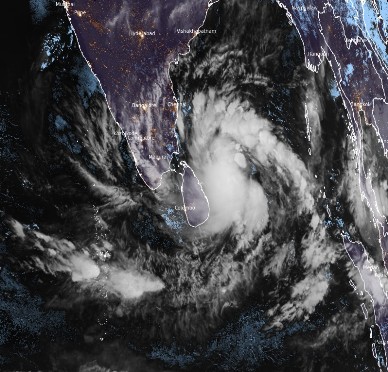Cyclone Burevi makes landfall in Sri Lanka’s east coast
COLOMBO – The Department of Meteorology on Wednesday (2) evening confirmed that cyclone ‘Burevi’ had entered Sri Lanka’s through Mullaitivu and Trincomalee areas, and made landfall it the eastern coast, as officials began moving people in coastal communities to safer ground, alerting search and rescue teams and preparing evacuation centres.
Irrigation Minister Chamal Rajapaksa told Parliament on Wednesday that seven districts, Jaffna, Trincomalee, Mullaitivu, Mannar, Batticaloa, Vavuniya and Puttalam were expected to be the worst hit.
The Disaster Management Centre (DMC) said Parts of the North and East have been flooded as Burevi made landfall, adding that trees were uprooted in some areas and at least four people are reported to have been injured.
The DMC said a number of people have been evacuated to safer locations in the North and East.
Earlier in the day, the Met Department issued red alerts for the Northern, North Central, Eastern, North Western, Western, Central and Sabaragamuwa Provinces, and urged the public to be vigilant and fishermen to stay ashore, warning of strong, gusty winds of 80-100 kmph strength at times on both days and very heavy rainfall above 200 mm at some places with intermittent showers at others.
It also warned of a possible one-metre high storm surge above the astronomical tide would likely inundate low lying areas in the Eastern Province.
The Department forecast the cyclone was very likely to move nearly westwards after making landfall, and emerge into the Gulf of Mannar, and warned naval and fishing communities not to venture to the sea areas around the island until further notice. It also urged those who are out at sea in the areas extending from Kankesanturai to Pottuvil and Trincomalee to return to the coast or move safer areas immediately.
Warnings were also issued of possible damage to huts, temporary shelters and light structures, destruction of roof tops with roofing sheets being blown off, damage to power and communication lines, uprooting of large trees and breaking of tree branches, damage to paddy crops, banana, papaya trees and orchards, damage to smaller vessels and yachts anchored in harbours, flash floods and sea water inundation in low lying areas in the near coast.
Meanwhile, a spokesman for the Sri Lanka Navy said it had sailed its bigger vessels normally anchored in Trinco harbour to Hambantota and anchored them there.
Rajapaksa said local officials had inspected houses in the path of the cyclone and advised householders to cut down overhanging branches of trees and take other actions to ensure that the damage to their houses is minimized.
The minister said areas prone to flash floods had been identified and evacuation centres prepared in case that occurs.
He added that armed forces and Police have been alerted and search and rescue teams are on standby in the threatened areas.
The DMC warned the cyclone will bring a storm surge in the sea that will primarily affect the coastal areas.
DMC spokesman Pradeep Kodipilli advised people in the coastal to stay indoors and if possible go to concrete buildings and take shelter until the danger recedes.
-ENCL


